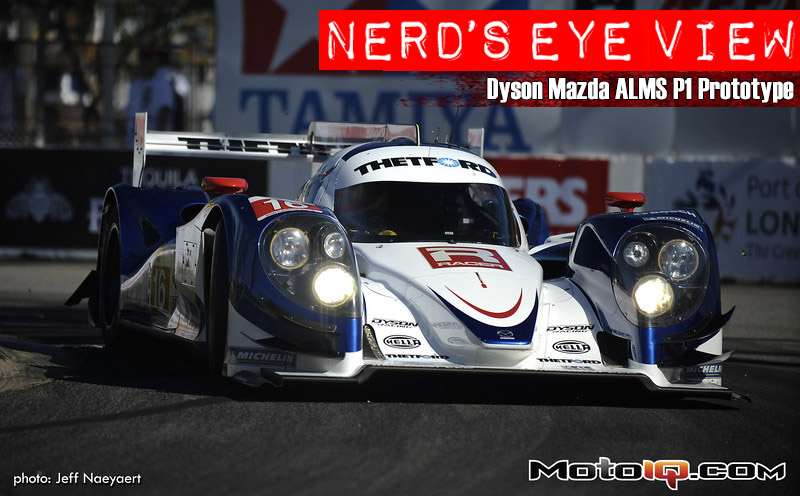
Nerd's Eye View: The Dyson Mazda ALMS P1 Prototype
I am old enough to have been around during what I consider to be the golden era of American road racing in the 80's. In this time we saw the rise of IMSA with the outrageous GTP prototypes and the exotic sort of production based GTO and GTU cars. SCCA had Trans Am and even CART Open wheelers were sporting awesome technology rivaling Formula One with closer, more exciting racing. I was lucky enough to have been a fan during this time and later on in the decade a participant.
Fast forward to the present. Interest in road racing in this country is at an all time low. Open wheel racing has turned into an expensive spec class and spectators and TV coverage are down to almost nothing. All anyone seems to care about is NASCAR which in itself does consist of really super high dollar and high tech spec cars as well. For the tech nerd fan things seem to be looking grim.
There is hope on the horizon though, ALMS has the exotic Prototype cars reminiscent of years gone by, SCCA's World Challenge series is once again being populated by diverse and technically cool cars and Grand Am is getting stronger and more interesting every year. In 2014 there will be an attempt to globally unify many of the World's racing classes so international competition of exotic road racing machinery may become possible. The thing is, will the jaded instant gratification addicted American public ever embrace real racing again? God we hope so.
During the Long Beach race weekend we were lucky enough to be able to get a close look at one of the most sophisticated cars on the ALMS circuit, The Dyson Mazda P1 Prototype. We hope that there will be a resurgence in interest in road racing and there will be more of these cars with fans and corporate sponsors behind them in the near future. These machines are so much more interesting than NASCAR!
 |
We managed to get in and shoot the car while it was down during an engine change. The engine was damaged during practice and the team was scrambling to get the car back on the track. Because of all the hustle we had to stay out of the way and most of our shots were quick snap shots and not all the pictures we would have liked. The team's business also prevented us from asking much in the way of questions. |
 |
To replace the engine the entire rear of the car is removed. In typical race car fashion the main part of the chassis is a carbon fiber monocoque tub that the engine and transaxle bolt to. The transaxle supports the rear suspension with the engine serving as a stressed member. The aero parts and some of the chassis load are supported by a steel tubular trellis assembly as well. Here the crew has removed the bodywork, the transaxle and are about to remove the engine. |
 |
The engine is called a Mazda MZR-R to give it some connection to a Mazda production motor. It is a bespoke racing engine designed from a clean sheet of paper but it is loosely derived from an MZ series engine found in the CX-7 diesel as well as the Mazdaspeed 3 and 6. A modified production engine was considered but it was decided to start from a clean sheet of paper due to the stressed member aspect of the chassis and the packaging issues that adding a drysump to a production engine might cause. |
 |
The engine is called the P70 by AER and supercedes the successful LMP 2 engine the P07. Most notably the P70 is a very small and light engine, exceeding the performance of the P07 by about 10 percent while being significantly smaller and lighter. The carbon intake manifold has two stages of injector, port injectors and shower injectors at the trumpets for charge cooling. Charge cooling can be considerable as the car runs on bio ethanol race fuel. Ethanol has double the latent heat of vaporization that gasoline does which makes for substantial charge cooling. |
 |
The AER P70 has a displacement just under 2000cc with a bore of 90mm and a stroke of 78.4. With advanced casting technology and FEA design being used to pare every bit of excess weight possible from the block and head, the P70 weighs in at a feathery 163 lbs! This is the smallest and lightest engine currently being raced in sports prototypes in the world. The P70 uses AER's in house ECU, the Life Racing F88 for controlling the fuel and firing the coil on plug ignition. In this shot you can see the top part of the tubular steel support trellis over the engine. The trellis takes a lot of load off of the block. Old school race cars put all of the load through the engine but older engines were much beefier and the trellis is used to avoid cylinder and main distortion which could cause a loss of power or durability. |



